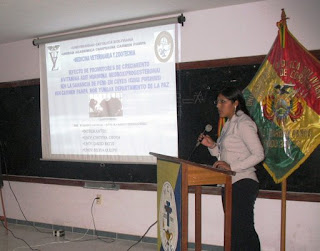The agronomy group presented an experiment looking at the best way to graft citrus trees (on young branches with strips of plastic).

Photo: Wilma Pari, Harold Rivera, Marco Pardo and Ever Misange talk about orange tree grafting.
The education students worked with children 6 to 24 months and scored them on different developmental scales before and after sessions of constructive play to look at the effect of stimulation on their development.

Photo: Two education students discuss their project.
A young women in the vet and animal science department examined the effect of vitamins and a progesterone blocker on the development of guinea pigs. Vitamins stimulated growth more than the hormone and the control animals.

Photo: Cintia Otoya talks about her guinea pig experiment.
The nursing students presented the results of a survey about the prevelance and causes of athlete's foot in students at the UAC. Students in the agronomy department shower only 2 times per week on average, but had less foot fungus than other students; the future nurses recommended more frequent scrubbing of the communal shower stalls.

Photo: Students Bertha, Leonela and Paola pose with their research advisor Dr. Cinzia Quezada (in white).
And the nurses won it! We are proud of all of the students who participated, and especially proud of the finalists.
The night ended with an award for Manuel Loza, a biochemistry professor who was instrumental in the creation of these competitions. He received a pewter clock inscribed with his name and a dedication.

Photo: Manuel Loza admires his new clock as the night's M.C. Hugh Smeltekop looks on.
We were also grateful for the distinguished panel of judges of the evening: Our director Father Freddy del Villar, the coordinator of satellite campuses of the Catholic University of Bolivia Gustavo Escalier, a social worker from the Alto Sonia Castro, and a doctor from the Hospital of the Yungas in Coroico Dr. José Luis Oblitas.

Photo: José Luis Oblitas, Sonia Castro, Gustavo Escalier and Padre Freddy del Villar sit at the judges table.
The funds for these research projects came from a donation by Dr. Carol Wake at South Dakota State University. A very warm thank you to Carol from everyone here in Carmen Pampa. Abrazos!


